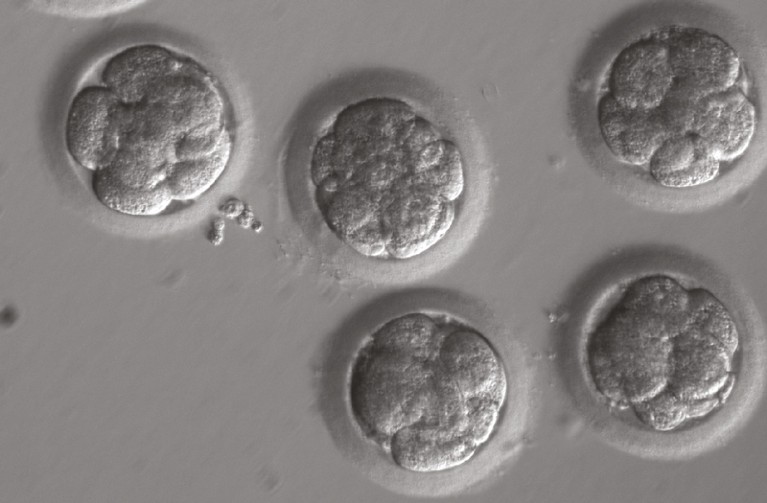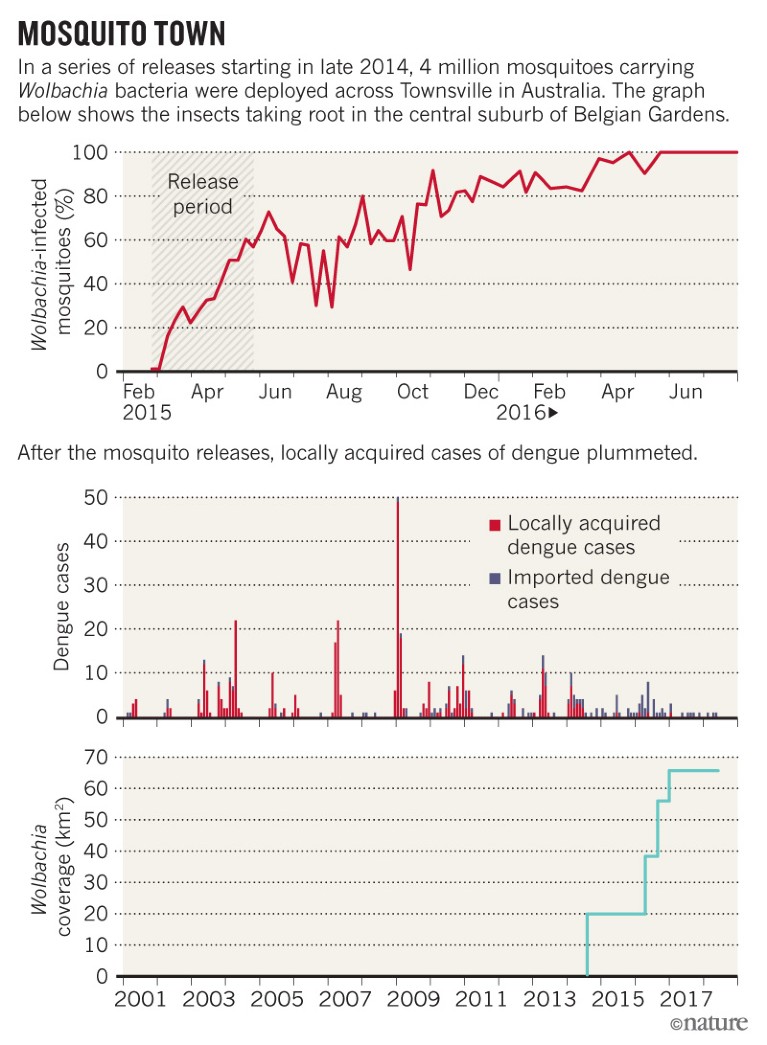EVENTS
Canadian telescope spots cosmic burst A radio telescope, inaugurated last year, has detected its first fast radio burst (FRB), giving astronomers a powerful weapon for studying these mysterious events. The 2-millisecond signal, announced on 1 August, heralds an expected deluge for the Canadian Hydrogen Intensity Mapping Experiment (CHIME): once fully operational, CHIME should record more than a dozen FRBs a day. Astrophysicists have proposed a number of explanations for these events — which are fast bursts of radio energy — from evaporating black holes to erupting neutron stars, but data have been scarce so far. CHIME consists of 4 reflectors shaped like half-pipes, each 100 metres long. Its primary science goal is to map the density of interstellar hydrogen across the Universe in the epoch between 10 billion and 8 billion years ago.

The CHIME telescope in Canada has detected mysterious astronomical signals known as fast radio bursts.Credit: CHIME Collaboration
Ebola returns Barely a week after the end of an outbreak of Ebola virus was declared in the northwest of the Democratic Republic of the Congo, a new outbreak has emerged in North Kivu province, some 2,500 kilometres to the east. The latest episode is potentially more dangerous, because it is in a war zone, which will complicate response efforts. Many thousands of people are fleeing from violent conflict to other regions and to nearby nations such as Uganda, Rwanda and Burundi. So far, 16 cases of Ebola have been confirmed in the latest outbreak, and the virus is thought to have caused more than 30 deaths. Confirmation of the virus strain’s identity is expected this week; it is suspected to be the EBOV strain, for which an experimental vaccine is available. However, the movement of people will complicate the ‘ring vaccination’ strategy used in previous outbreaks, because this depends on rapidly immunizing the contacts of infected people and their contacts, as well as front-line responders. “We are at the top of the degree of difficulty scale in terms of responding to this outbreak,” said Peter Salama, head of the World Health Organization’s emergencies programme, on 3 August.
POLICY
Genetic privacy A group of DNA-testing companies has developed guidelines for sharing users’ information with law-enforcement and for-profit companies. On 31 July, 23andMe in Mountain View, California, Ancestry in Lehi, Utah, and several other direct-to-consumer companies released a document describing standards for how genetic data are stored and used — including user privacy, data security and the legal process for sharing data with police. The guidelines also ban the sharing of genetic data with entities such as employers and insurance companies without the user’s consent. The move comes after California investigators identified a suspect in a series of rapes and murders known as the Golden State Killer case by comparing DNA from crime scenes with genetic data that the suspect’s relatives had submitted to the testing company GEDmatch. The privacy of genetic data also drew attention in July, when 23andMe announced that it would share user data, with permission, with GlaxoSmithKline after the pharmaceutical giant invested US$300 million.
FUNDING
Grants cancelled The March of Dimes foundation, a US non-profit group focused on improving child health, has abruptly terminated 37 research grants totalling US$3 million. On 24 July, grant recipients received an e-mail from the foundation in White Plains, New York, informing them that their three-year grants had been cut off retroactively, starting on 30 June. The foundation made the decision to revoke the grants because of a budget shortfall. Going forward, the group’s board of directors has decided to restrict its research support to studies on reducing premature births, said Kelle Moley, the March of Dimes’ chief scientific officer. The organization will continue to fund young investigators through its prestigious Basil O’Connor awards.
RESEARCH
Embryo editing The authors of a controversial study — which used gene editing in human embryos in an effort to fix a disease mutation — have responded to criticisms of their work in an 8 August communication to Nature. In the original study, published last August (H. Ma et al. Nature 548, 413–419; 2017), a team led by reproductive biologist Shoukhrat Mitalipov at Oregon Health & Science University in Portland described using CRISPR–Cas9 gene editing to correct a mutation, which causes a heart condition, in human embryos. The embryos (pictured) were created from sperm that carried the mutation and healthy donor eggs; Mitalipov’s team reported that the sperm’s faulty version of the gene was replaced with a copy from the egg during the gene-editing process. Critics of the work — including authors who have formally published their responses in two separate reports in Nature this week — say that Mitalipov’s team had not ruled out alternative explanations for its results. In its response, Mitalipov’s team reports new data it says back up its claims that gene correction occurred in the manner proposed.

Eight-cell embryos edited using CRISPR–Cas9.Credit: H. Ma et al./Nature
UNIVERSITIES
Power imbalance Academics should be removed from their supervisory, teaching or assessment roles if they develop a romantic relationship with one of their students, say organizations that represent Australian universities and students. Guidelines released on 1 August state that romantic relationships between academic supervisors and their students are never appropriate because they create a power imbalance. Although some institutions have their own policies in place for addressing such situations, Australia is one of the first countries to issue national principles. They were developed by four organizations that represent the country’s universities, academics and postgraduate students. The guidelines were created in response to a 2017 survey of more than 30,000 Australian university students about their experiences of sexual harassment or sexual assault. It found that postgraduate students were almost twice as likely as undergraduates to have been sexually harassed by a lecturer or tutor.
PEOPLE
Scientists speak out The US Society for Neuroscience and the Federation of European Neuroscience Societies published a joint statement on 3 August criticizing the Max Planck Society (MPS) in Germany for its treatment of neuroscientist Nikos Logothetis, who used to run a primate laboratory. A director at the Max Planck Institute for Biological Cybernetics in Tübingen, Logothetis is charged with mistreatment of animals following allegations by animal-rights groups. A court has not ruled on the charges, which Logothetis denies. But the MPS has removed many of his responsibilities relating to animal research. The neuroscience societies, which together represent more than 60,000 scientists, say the MPS’s treatment of Logothetis sets an “alarming precedent” that disregards the presumption of innocence. MPS president Martin Stratman declined to comment on the statement, but in response to earlier criticism of MPS’s handling of the affair, he said that the society restricted Logothetis’s work to reassure the public that it takes animal welfare seriously.
Krauss departs Physicist Lawrence Krauss, a prominent sceptic and writer, is leaving his post as director of the Origins Project at Arizona State University (ASU) in Tempe, a multidisciplinary centre that he founded nine years ago. In February, BuzzFeed News reported a number of allegations of sexual harassment against Krauss. The university placed him on paid leave in March while it investigated the reports. Krauss, who has previously denied the allegations, declined Nature’s request for comment. In a 2 August tweet, Krauss said that the university had decided not to renew his appointment as director when it expired in July. ASU confirmed the decision but declined to comment further. Krauss’s successor will be Lindy Elkins-Tanton, a planetary scientist at ASU. The Origins Project holds workshops, lectures and other discussions aimed at exploring the origins of the Universe, life, consciousness and more.
TREND WATCH
An Australian city has seen local cases of dengue fever plunge after it was blanketed with mosquitoes modified to block transmission of the virus. Over 28 months beginning in October 2014, researchers and community members released roughly 4 million Aedes aegypti mosquitoes over 66 square kilometres in Townsville. The insects carried Wolbachia bacteria that block them from transmitting dengue, Zika and some other disease-causing viruses. A team led by microbiologist Scott O’Neill at Monash University in Clayton, Australia, tracked the mosquito release — the first time the strategy has been trialled across an entire city. Wolbachia-infected mosquitoes quickly spread the bacteria to local mosquito populations. In many suburbs, nearly 100% of mosquitoes carried Wolbachia one year after the release period. Townsville, which has a population of around 187,000, has faced periodic dengue outbreaks since 2001. In the 44 months after the releases began, however, authorities recorded just 4 locally acquired dengue cases, compared with 54 locally acquired cases over the 44 preceding months. (During the same period after the release, 51 imported cases were reported.)

Source: S. L. O’Neill et al. Gates Open Res. 2, 36 (2018)



